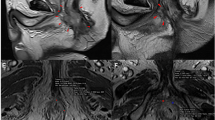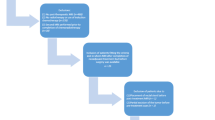Abstract
Objectives
To evaluate the diagnostic value of signal intensity (SI)-selected volumetry findings in T2-weighted magnetic resonance imaging (MRI) as a potential biomarker for predicting pathological complete response (pCR) to preoperative chemoradiotherapy (CRT) in patients with rectal cancer.
Methods
Forty consecutive patients with pCR after preoperative CRT were compared with 80 age- and sex-matched non-pCR patients in a case-control study. SI-selected tumor volume was measured on post-CRT T2-weighted MRI, which included voxels of the treated tumor exceeding the SI (obturator internus muscle SI + [ischiorectal fossa fat SI – obturator internus muscle SI] × 0.2). Three blinded readers independently rated five-point pCR confidence scores and compared the diagnostic outcome with SI-selected volumetry findings. The SI-selected volumetry protocol was validated in 30 additional rectal cancer patients.
Results
The area under the receiver-operating characteristic curve (AUC) of SI-selected volumetry for pCR prediction was 0.831, with an optimal cutoff value of 649.6 mm3 (sensitivity 0.850, specificity 0.725). The AUC of the SI-selected tumor volume was significantly greater than the pooled AUC of readers (0.707, p < 0.001). At this cutoff, the validation trial yielded an accuracy of 0.87.
Conclusion
SI-selected volumetry in post-CRT T2-weighted MRI can help predict pCR after preoperative CRT in patients with rectal cancer.
Key Points
• Fibrosis and viable tumor MRI signal intensities (SIs) are difficult to distinguish.
• T2 SI-selected volumetry yields high diagnostic performance for assessing pathological complete response.
• T2 SI-selected volumetry is significantly more accurate than readers and non-SI-selected volumetry.
• Post-chemoradiation therapy T2-weighted MRI SI-selected volumetry facilitates prediction of pathological complete response.






Similar content being viewed by others
Abbreviations
- AUC:
-
The area under the receiver-operating characteristic curve
- CRT:
-
Chemoradiotherapy
- CS:
-
Confidence score
- DCE:
-
Dynamic contrast-enhanced
- DFS:
-
Disease-free survival
- DWI:
-
Diffusion-weighted imaging
- MRI:
-
Magnetic resonance imaging
- mrTRG:
-
Tumor regression grade on MRI
- pCR:
-
Pathological complete response
- pGR:
-
Pathological good response
- ROC:
-
Receiver-operating characteristic
- ROI:
-
Region of interest
- SI:
-
Signal intensity
- SIC:
-
Signal intensity category
- TME:
-
Total mesorectal excision
- TRG:
-
Tumor regression grade
References
Park IJ, Yu CS (2014) Current issues in locally advanced colorectal cancer treated by preoperative chemoradiotherapy. World J Gastroenterol 20:2023–2029
Chan AK, Wong A, Jenken D, Heine J, Buie D, Johnson D (2005) Posttreatment TNM staging is a prognostic indicator of survival and recurrence in tethered or fixed rectal carcinoma after preoperative chemotherapy and radiotherapy. Int J Radiat Oncol Biol Phys 61:665–677
Glynne-Jones R, Wallace M, Livingstone JI, Meyrick-Thomas J (2008) Complete clinical response after preoperative chemoradiation in rectal cancer: is a “wait and see” policy justified? Dis Colon Rectum 51:10–19 discussion 19-20
Santos MD, Silva C, Rocha A, Matos E, Nogueira C, Lopes C (2013) Tumor regression grades: can they influence rectal cancer therapy decision tree? Int J Surg Oncol 2013:572149
Mignanelli ED, de Campos-Lobato LF, Stocchi L, Lavery IC, Dietz DW (2010) Downstaging after chemoradiotherapy for locally advanced rectal cancer: is there more (tumor) than meets the eye? Dis Colon Rectum 53:251–256
Habr-Gama A, Perez RO, Nadalin W et al (2004) Operative versus nonoperative treatment for stage 0 distal rectal cancer following chemoradiation therapy: long-term results. Ann Surg 240:711–717 discussion 717-718
Renehan AG, Malcomson L, Emsley R et al (2016) Watch-and-wait approach versus surgical resection after chemoradiotherapy for patients with rectal cancer (the OnCoRe project): a propensity-score matched cohort analysis. Lancet Oncol 17:174–183
Beets-Tan RGH, Lambregts DMJ, Maas M et al (2018) Magnetic resonance imaging for clinical management of rectal cancer: Updated recommendations from the 2016 European Society of Gastrointestinal and Abdominal Radiology (ESGAR) consensus meeting. Eur Radiol 28:1465–1475
Chen CC, Lee RC, Lin JK, Wang LW, Yang SH (2005) How accurate is magnetic resonance imaging in restaging rectal cancer in patients receiving preoperative combined chemoradiotherapy? Dis Colon Rectum 48:722–728
Barbaro B, Vitale R, Leccisotti L et al (2010) Restaging locally advanced rectal cancer with MR imaging after chemoradiation therapy. Radiographics 30:699–716
Kim YH, Kim DY, Kim TH et al (2005) Usefulness of magnetic resonance volumetric evaluation in predicting response to preoperative concurrent chemoradiotherapy in patients with resectable rectal cancer. Int J Radiat Oncol Biol Phys 62:761–768
Curvo-Semedo L, Lambregts DMJ, Maas M et al (2011) Rectal Cancer: Assessment of complete response to preoperative combined radiation therapy with chemotherapy—conventional MR volumetry versus diffusion-weighted MR imaging. Radiology 260:734–743
Ha HI, Kim AY, Yu CS, Park SH, Ha HK (2013) Locally advanced rectal cancer: diffusion-weighted MR tumour volumetry and the apparent diffusion coefficient for evaluating complete remission after preoperative chemoradiation therapy. Eur Radiol 23:3345–3353
Patel UB, Blomqvist LK, Taylor F et al (2012) MRI after treatment of locally advanced rectal cancer: how to report tumor response—the MERCURY experience. AJR Am J Roentgenol 199:W486–W495
Mandard AM, Dalibard F, Mandard JC et al (1994) Pathologic assessment of tumor regression after preoperative chemoradiotherapy of esophageal carcinoma. Clinicopathologic correlations. Cancer 73:2680–2686
Vecchio FM, Valentini V, Minsky BD et al (2005) The relationship of pathologic tumor regression grade (TRG) and outcomes after preoperative therapy in rectal cancer. Int J Radiat Oncol Biol Phys 62:752–760
Ho DE, Imai K, King G, Stuart EA (2011) MatchIt: nonparametric preprocessing for parametric causal inference. J Stat Softw 42:1–28
DeLong ER, DeLong DM, Clarke-Pearson DL (1988) Comparing the areas under two or more correlated receiver operating characteristic curves: a nonparametric approach. Biometrics 44:837–845
Hillis SL, Berbaum KS, Metz CE (2008) Recent developments in the Dorfman-Berbaum-Metz procedure for multireader ROC study analysis. Acad Radiol 15:647–661
Shrout PE, Fleiss JL (1979) Intraclass correlations: uses in assessing rater reliability. Psychol Bull 86:420–428
Busing KA, Kilian AK, Schaible T, Debus A, Weiss C, Neff KW (2008) Reliability and validity of MR image lung volume measurement in fetuses with congenital diaphragmatic hernia and in vitro lung models. Radiology 246:553–561
Stollfuss JC, Becker K, Sendler A et al (2006) Rectal carcinoma: high-spatial-resolution MR imaging and T2 quantification in rectal cancer specimens. Radiology 241:132–141
Kluza E, Rozeboom ED, Maas M et al (2013) T2 weighted signal intensity evolution may predict pathological complete response after treatment for rectal cancer. Eur Radiol 23:253–261
Dinh AH, Melodelima C, Souchon R et al (2016) Quantitative analysis of prostate multiparametric MR images for detection of aggressive prostate cancer in the peripheral zone: a multiple imager study. Radiology 280:117–127
Habr-Gama A, Perez RO, Proscurshim I et al (2006) Patterns of failure and survival for nonoperative treatment of stage c0 distal rectal cancer following neoadjuvant chemoradiation therapy. J Gastrointest Surg 10:1319–1328 discussion 1328-1319
Bujko K (2012) Timing of surgery following preoperative therapy in rectal cancer: there is no need for a prospective randomized trial. Dis Colon Rectum 55:e31 author reply e31-32
Suit HD, Gallager HS (1964) Intact tumor cells in irradiated tissue. Arch Pathol 78:648–651
Patel UB, Taylor F, Blomqvist L et al (2011) Magnetic resonance imaging-detected tumor response for locally advanced rectal cancer predicts survival outcomes: MERCURY Experience. J Clin Oncol 29:3753–3760
Battersby NJ, Moran B, Yu S, Tekkis P, Brown G (2014) MR imaging for rectal cancer: the role in staging the primary and response to neoadjuvant therapy. Expert Rev Gastroenterol Hepatol 8:703–719
Siddiqui MR, Gormly KL, Bhoday J et al (2016) Interobserver agreement of radiologists assessing the response of rectal cancers to preoperative chemoradiation using the MRI tumour regression grading (mrTRG). Clin Radiol 71:854–862
Hotker AM, Tarlinton L, Mazaheri Y et al (2016) Multiparametric MRI in the assessment of response of rectal cancer to neoadjuvant chemoradiotherapy: A comparison of morphological, volumetric and functional MRI parameters. Eur Radiol. https://doi.org/10.1007/s00330-016-4283-9
Lambregts DM, Rao SX, Sassen S et al (2015) MRI and diffusion-weighted MRI volumetry for identification of complete tumor responders after preoperative chemoradiotherapy in patients with rectal cancer: a bi-institutional validation study. Ann Surg 262:1034–1039
Lambregts DM, Beets GL, Maas M et al (2011) Tumour ADC measurements in rectal cancer: effect of ROI methods on ADC values and interobserver variability. Eur Radiol 21:2567–2574
Funding
The authors state that this work has not received any funding.
Author information
Authors and Affiliations
Corresponding author
Ethics declarations
Guarantor
The scientific guarantor of this publication is Joon Seok Lim, MD, PhD.
Conflict of interest
The authors of this manuscript declare no relationships with any companies, whose products or services may be related to the subject matter of the article.
Statistics and biometry
One of the authors has significant statistical expertise (Kyunghwa Han, PhD).
Informed consent
Written informed consent was waived by the Institutional Review Board.
Ethical approval
Institutional Review Board approval was obtained.
Methodology
• retrospective
• case-control study
• performed at one institution
Electronic supplementary material
ESM 1
(DOCX 87 kb)
Rights and permissions
About this article
Cite this article
Kim, S., Han, K., Seo, N. et al. T2-weighted signal intensity-selected volumetry for prediction of pathological complete response after preoperative chemoradiotherapy in locally advanced rectal cancer. Eur Radiol 28, 5231–5240 (2018). https://doi.org/10.1007/s00330-018-5520-1
Received:
Revised:
Accepted:
Published:
Issue Date:
DOI: https://doi.org/10.1007/s00330-018-5520-1




